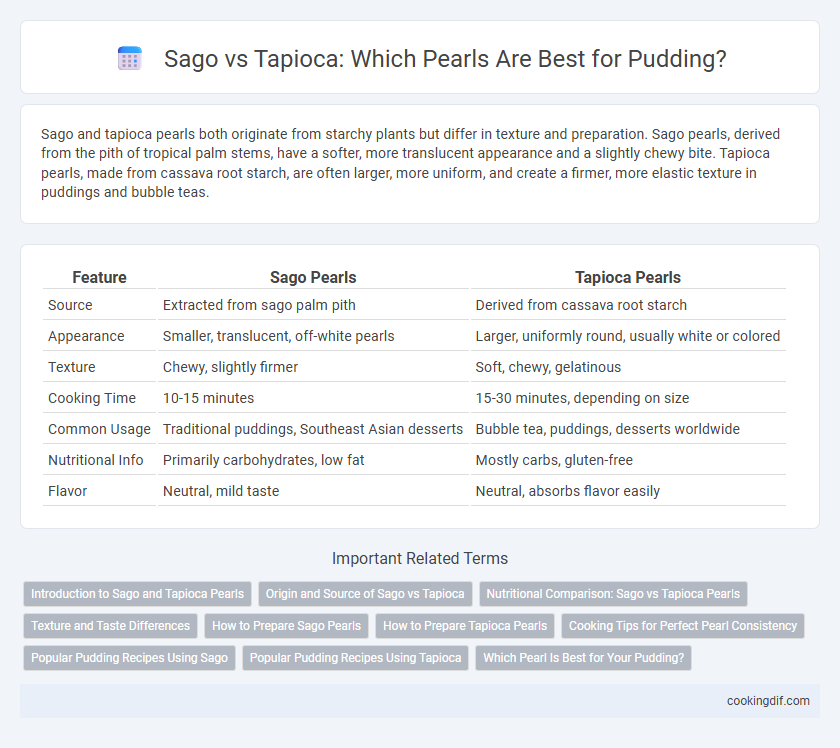Sago and tapioca pearls both originate from starchy plants but differ in texture and preparation. Sago pearls, derived from the pith of tropical palm stems, have a softer, more translucent appearance and a slightly chewy bite. Tapioca pearls, made from cassava root starch, are often larger, more uniform, and create a firmer, more elastic texture in puddings and bubble teas.
Table of Comparison
| Feature | Sago Pearls | Tapioca Pearls |
|---|---|---|
| Source | Extracted from sago palm pith | Derived from cassava root starch |
| Appearance | Smaller, translucent, off-white pearls | Larger, uniformly round, usually white or colored |
| Texture | Chewy, slightly firmer | Soft, chewy, gelatinous |
| Cooking Time | 10-15 minutes | 15-30 minutes, depending on size |
| Common Usage | Traditional puddings, Southeast Asian desserts | Bubble tea, puddings, desserts worldwide |
| Nutritional Info | Primarily carbohydrates, low fat | Mostly carbs, gluten-free |
| Flavor | Neutral, mild taste | Neutral, absorbs flavor easily |
Introduction to Sago and Tapioca Pearls
Sago and tapioca pearls are popular starch-based ingredients commonly used in puddings and desserts. Sago is derived from the pith of tropical palm stems, primarily Metroxylon sagu, while tapioca pearls come from the cassava root starch. Both pearls swell and become translucent when cooked, but tapioca pearls have a smoother texture and slightly sweeter taste compared to the more neutral-flavored sago pearls.
Origin and Source of Sago vs Tapioca
Sago pearls originate from the pith of various tropical palm trees, primarily the Metroxylon sagu species found in Southeast Asia, especially in countries like Indonesia and Malaysia. Tapioca pearls are derived from cassava root starch, native to South America but widely cultivated in tropical regions worldwide, including Brazil and Nigeria. Both sago and tapioca pearls serve as starchy bases in puddings, but their distinct plant origins influence texture and culinary uses.
Nutritional Comparison: Sago vs Tapioca Pearls
Sago pearls contain slightly higher carbohydrate content and provide minimal amounts of protein and fiber compared to tapioca pearls, which are primarily composed of starch and offer fewer nutrients overall. Both sago and tapioca pearls are low in fat and calories, making them suitable for energy-boosting puddings but less effective for meeting daily nutritional needs. Sago offers trace minerals like calcium and iron, giving it a marginal nutritional advantage over tapioca, which lacks these micronutrients.
Texture and Taste Differences
Sago pearls have a slightly softer, more gelatinous texture compared to the firmer, chewier consistency of tapioca pearls, making sago ideal for light, delicate puddings. Tapioca pearls offer a mildly sweet flavor that enhances the overall taste of desserts, while sago tends to be more neutral, absorbing surrounding flavors more readily. For pudding recipes, the choice between sago and tapioca pearls significantly influences the mouthfeel and flavor intensity of the final dish.
How to Prepare Sago Pearls
To prepare sago pearls, rinse them under cold water until the water runs clear to remove excess starch. Boil a pot of water, then add the sago pearls and cook for about 10-15 minutes, stirring occasionally to prevent sticking. Once the pearls turn translucent with a small opaque center, drain and rinse with cold water to stop cooking and remove any residual starch.
How to Prepare Tapioca Pearls
To prepare tapioca pearls for pudding, soak them in warm water for about 30 minutes before boiling to reduce cooking time. Boil the pearls in water, stirring frequently, until they become translucent and chewy, typically 10 to 15 minutes. Drain and rinse with cold water, then soak in sugar syrup or milk for enhanced flavor and texture compared to sago pearls.
Cooking Tips for Perfect Pearl Consistency
Sago pearls require soaking before cooking to achieve a soft, chewy texture, whereas tapioca pearls benefit from boiling in ample water until they turn translucent for the perfect bite. Maintaining a gentle simmer and stirring occasionally prevents clumping and promotes even cooking for both types of pearls. Draining and rinsing cooked pearls under cold water helps remove excess starch and preserves the desired consistency in puddings.
Popular Pudding Recipes Using Sago
Sago pearls, derived from the pith of tropical palm stems, are a popular choice in pudding recipes due to their translucent appearance and chewy texture, which differentiate them from the more opaque tapioca pearls made from cassava starch. Classic Asian desserts like Sago Gula Melaka and Thai Coconut Sago Pudding showcase sago's ability to absorb flavors while maintaining a delicate bite, making it a favored ingredient in many traditional sweet dishes. For pudding enthusiasts seeking authentic texture and a subtle, earthy taste, sago pearls offer a distinctive alternative that enhances the overall sensory experience.
Popular Pudding Recipes Using Tapioca
Tapioca pearls, derived from cassava starch, offer a smooth, chewy texture that is ideal for classic pudding recipes like traditional tapioca pudding and bubble tea. Compared to sago pearls, tapioca pearls absorb flavors more evenly and provide a translucent appearance that enhances the dessert's visual appeal. Popular pudding recipes using tapioca pearls often incorporate coconut milk, vanilla, and sweeteners to create a rich, creamy consistency that is beloved worldwide.
Which Pearl Is Best for Your Pudding?
Sago pearls, derived from the sago palm, offer a softer texture and clearer appearance, making them ideal for delicate puddings with subtle flavors. Tapioca pearls, made from cassava starch, provide a chewier bite and achieve a more translucent finish, enhancing creamy, rich puddings. Choosing between sago and tapioca pearls depends on whether you prefer a tender or chewy texture to complement your pudding's flavor profile.
Sago vs tapioca for pearls Infographic

 cookingdif.com
cookingdif.com